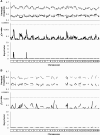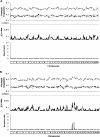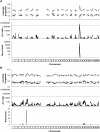Genome scans for transmission ratio distortion regions in mice
- PMID: 22367040
- PMCID: PMC3338264
- DOI: 10.1534/genetics.111.135988
Genome scans for transmission ratio distortion regions in mice
Abstract
Transmission ratio distortion (TRD) is the departure from the expected genotypic frequencies under Mendelian inheritance. This departure can be due to multiple physiological mechanisms during gametogenesis, fertilization, fetal and embryonic development, and early neonatal life. Although a few TRD loci have been reported in mouse, inheritance patterns have never been evaluated for TRD. In this article, we developed a Bayesian binomial model accounting for additive and dominant deviation TRD mechanisms. Moreover, this model was used to perform genome-wide scans for TRD quantitative trait loci (QTL) on six F2 mouse crosses involving between 296 and 541 mice and between 72 and 1854 genetic markers. Statistical significance of each model was checked at each genetic marker with Bayes factors. Genome scans revealed overdominance TRD QTL located in mouse chromosomes 1, 2, 12, 13, and 14 and additive TRD QTL in mouse chromosomes 2, 3, and 15, although these results did not replicate across mouse crosses. This research contributes new statistical tools for the analysis of specific genetic patterns involved in TRD in F2 populations, our results suggesting a relevant incidence of TRD phenomena in mouse with important implications for both statistical analyses and biological research.
Figures





Similar articles
-
Implementation of Bayesian methods to identify SNP and haplotype regions with transmission ratio distortion across the whole genome: TRDscan v.1.0.J Dairy Sci. 2019 Apr;102(4):3175-3188. doi: 10.3168/jds.2018-15296. Epub 2019 Feb 7. J Dairy Sci. 2019. PMID: 30738671
-
Proceedings of the SMBE Tri-National Young Investigators' Workshop 2005. Genome-wide associations between hybrid sterility QTL and marker transmission ratio distortion.Mol Biol Evol. 2006 May;23(5):973-80. doi: 10.1093/molbev/msj112. Epub 2006 Feb 22. Mol Biol Evol. 2006. PMID: 16495346
-
A flexible bayesian model for testing for transmission ratio distortion.Genetics. 2014 Dec;198(4):1357-67. doi: 10.1534/genetics.114.169607. Epub 2014 Sep 29. Genetics. 2014. PMID: 25271302 Free PMC article.
-
Transmission ratio distortion: review of concept and implications for genetic association studies.Hum Genet. 2013 Mar;132(3):245-63. doi: 10.1007/s00439-012-1257-0. Epub 2012 Dec 15. Hum Genet. 2013. PMID: 23242375 Review.
-
Standard Deviations: The Biological Bases of Transmission Ratio Distortion.Annu Rev Genet. 2019 Dec 3;53:347-372. doi: 10.1146/annurev-genet-112618-043905. Epub 2019 Sep 10. Annu Rev Genet. 2019. PMID: 31505133 Review.
Cited by
-
Discovering lethal alleles across the turkey genome using a transmission ratio distortion approach.Anim Genet. 2020 Dec;51(6):876-889. doi: 10.1111/age.13003. Epub 2020 Oct 1. Anim Genet. 2020. PMID: 33006154 Free PMC article.
-
Fine Mapping of Two Interacting Loci for Transmission Ratio Distortion in Rice (Oryza sativa L.).Front Plant Sci. 2022 Mar 29;13:866276. doi: 10.3389/fpls.2022.866276. eCollection 2022. Front Plant Sci. 2022. PMID: 35422832 Free PMC article.
-
Genomic collinearity and the genetic architecture of floral differences between the homoploid hybrid species Iris nelsonii and one of its progenitors, Iris hexagona.Heredity (Edinb). 2013 Jan;110(1):63-70. doi: 10.1038/hdy.2012.62. Epub 2012 Oct 10. Heredity (Edinb). 2013. PMID: 23047202 Free PMC article.
-
Mining massive genomic data of two Swiss Braunvieh cattle populations reveals six novel candidate variants that impair reproductive success.Genet Sel Evol. 2021 Dec 16;53(1):95. doi: 10.1186/s12711-021-00686-3. Genet Sel Evol. 2021. PMID: 34915862 Free PMC article.
-
Genomic screening of allelic and genotypic transmission ratio distortion in horse.PLoS One. 2023 Aug 9;18(8):e0289066. doi: 10.1371/journal.pone.0289066. eCollection 2023. PLoS One. 2023. PMID: 37556504 Free PMC article.
References
-
- Agulnik S. I., Agulnik A. I., Ruvinsky A. O., 1990. Meiotic drive in female mice heterozygous for the HSR insert on chromosome 1. Genet. Res. 55: 97–100. - PubMed
-
- Bonferroni C. E., 1930. Elementi di Statistica Generale. Libreria Seber, Florence, Italy.
-
- Bruce A. B., 1910. The Mendelian theory of heredity and the augmentation of vigor. Science 32: 627–628. - PubMed
-
- Canham R. P., Birdsall D. A., Cameron D. G., 1970. Disturbed segregation at the transferring locus of the deer mouse. Genet. Res. 16: 355–377. - PubMed
Publication types
MeSH terms
Grants and funding
LinkOut - more resources
Full Text Sources
Miscellaneous

